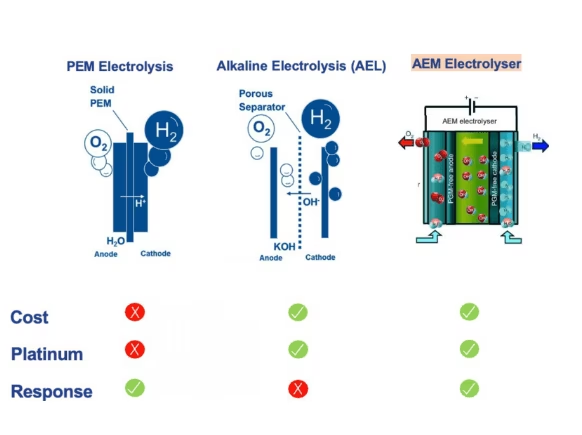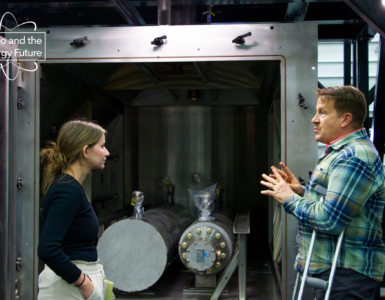$2/kg green hydrogen cost? This company thinks it can beat that with new tech.
Melbourne-based hydrogen start-up, Cavendish Renewable Technology (CRT), believes it has a lucrative solution to lowering green hydrogen costs below the critical $2/kg price point, making it competitive with fossil fuels.
The company specialises in low-cost hydrogen electrolyser technologies, which use an electrical current to separate hydrogen from oxygen in water and reckons its proprietary Anion Exchange Membrane (AEM) electrolyser can get green hydrogen costs down to around $1.90/kg.
While there are three main types of electrolysers on the market – proton exchange membrane (PEM), alkaline (AEL) and solid oxides – Cavendish CEO Ani Kulkarni says AEM electrolysers are the sweet spot between the other two benchmark technologies.
🔥 What about we co-host a webinar? Let's educate, captivate, and convert the hydrogen economy!
Hydrogen Central is the global go-to online magazine for the hydrogen economy, we can help you host impactful webinars that become a global reference on your topic and are an evergreen source of leads. Click here to request more details
Ani Kulkarni, Cavendish CEO said:
One of the main issues with alkaline electrolysers is they don’t respond very well to renewable energy fluctuations, which are intermittent in nature.
“You end up using a lot of renewable energy in the process, so overall they have a slow response to changes. On the other hand, PEM electrolysers have a quicker response rate but are more expensive. We are hoping our AEM electrolyser technology will fill the gap.”
Experienced hydrogen expert
Kulkarni, a senior technologist with 20 years of experience in developing fuel cells and electrolysers, is no stranger to the hydrogen sector.
Having worked with CSIRO’s Energy Business Unit for more than 12 years across key projects in electrolysis, hydrogen, and ammonia energy systems, and as a principal for hydrogen at Fortescue Future Industries, he now plans to complete CRT’s AEM prototype testing by March 2023 before starting the blueprinting process of an AEM manufacturing plant.
If all goes well, construction on what will be Australia’s first AEM manufacturing plant could begin in early 2024.
“By mid next year we hope the plant will be at least 20 per cent completed, this will enable us to at least pilot scale production by the end of next year,” he adds.
“When I say pilot scale, initial factory size will be around 20 megawatts before scaling up further to 250 megawatts, but that all depends on the supply chain.”
With plant design layouts prepared, and conversations underway with various institutional investors to drive funding for the factory, Kulkarni says CRT will begin evaluating three locations (Australia, the US and South America) for the AEM plant, subject to completion of prototype testing.
Global electrolyser market
About 100 million tonnes of hydrogen is produced around the world but that is expected to grow as interest picks up.
Kulkarni says the global electrolyser market is grossly under-serviced, with only 5% of the world’s hydrogen made using electrolysers.
“Even if we target 20 per cent of the total hydrogen market to produce around 20 million tonnes of green hydrogen – while it is a small percentage, it is more than what is being met at the moment,” he says.
“In Australia, Fortescue Future Industries (FFI) are doing some pioneering work trying to develop a hydrogen ecosystem, but we still don’t have enough manufacturing capacity. However, once we start a factory, that will hopefully add to hydrogen value chain.”
“With the degree of automation in our process, we have full confidence that our electrolyser will be cost competitive with other electrolysers made around the world – that is the key.”
Other plans down the track
Leveraging upon years of experience, CRT is also developing its unique C-Cell electrolyser technology, an innovative groundbreaking approach to electrolysis, which can be used for PEM/AEM/ and AEL electrolysers.
It can also be tailored for use in Redox Flow Batteries and fuel cells applications and has a high efficiency rate of up to 90%, compared to other electrolyser technologies.
While electrolyser technologies are CRT’s current focus, the company plans to expand into other areas such as ammonia once key deliverables in hydrogen are achieved.
“Hydrogen is difficult to transport from place A to B but when it is converted into ammonia it can be shipped or transported because that transport chain is well established. Millions of tonnes of ammonia is transported worldwide as we speak,” Kulkarni explains.
“Once the hydrogen arrives at the destination, rather than converting the ammonia back into hydrogen – which is a two-step process and very energy intensive – our solution converts ammonia directly into electricity using ammonia fuel cells.”
“This would accelerate the ammonia value chain and once we meet all our milestones, we plan to start working in this area by October this year.”
READ the latest news shaping the hydrogen market at Hydrogen Central
$2/kg green hydrogen? This company thinks it can beat that with new tech, February 7, 2023








